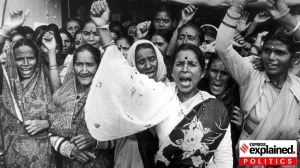Cricket Overkill?
What seemed like a great year for Indian cricket has collapsed under the weight of one of the most pathetic overseas tours in a long while. ...

What seemed like a great year for Indian cricket has collapsed under the weight of one of the most pathetic overseas tours in a long while. But, while the public demands answers, calls for the skipper’s head and is immersed in despair at the thought of the trend continuing during the world cup, spare a thought for a team that has played an astonishing 120 days of cricket in 12 months, all the while logging more frequent flyer points than even the peripatetic Ram Naik.
Consider this: Between January and December, our boys played England and Zimbabwe at home, travelled to the West Indies, returned home, travelled to England, returned home, went to Sri Lanka, returned home to host the West Indies before setting off on the fateful Kiwi tour (see map).
All very well if you’re a travelling salesman (or even Ram Naik) but not if you’re a bunch of sportsmen preparing for the biggest tournament of them all. Instead of a steady build-up to South Africa, Indian cricketers have played seven frenetic series in four continents, travelling 30,000 kilometres at home alone.
It’s not just the travelling, or the Tests; what can prove equally taxing on tours are the first-class matches. They’re a bit like the snacks before a grand dinner; a couple will get you in the mood, but too many can put you off the main course. So it seems inexplicable that India, on their 80-day England tour — the longest by any team in 2002 — played seven such matches, including a 3-day tie against the West Indies ‘A’ team.
Indeed, when the England and Wales Cricket Board (ECB) suggested that three Tests be played instead of four, BCCI president Jagmohan Dalmiya put his foot down, placing reciprocity and regional pride over rationale and the chance to give his players some rest.
|
INDIA ABROAD: AROUND THE WORLD IN 365 DAYS
|
Planning is not an Indian trait but one would have expected a better schedule in 2002 ahead of the world cup. While other top teams cut back on Tests and increased their ODI intake (see chart, below), India accelerated on both. The Indians played 40 one-dayers and 16 Tests while Australia — who anyway have specialised players for both forms — played 11 Tests and 30 ODIs. Any wonder why they are the best?
There is, of course, big money involved: more matches for the Indian team spell more revenue for the BCCI from sponsors and telecast rights. According to their agreement with the team sponsors, the BCCI gets Rs 55 lakh for each Test and Rs 45 lakh for each One-Day international, which in 2002 spells a total of around Rs 25 crores.
It’s also true that the Indians are the most highly paid cricketers and, the argument goes, should work as hard as the top professionals in any field. But these aren’t machines, these are finely tuned bodies that, though in better shape than most of ours, still need to be looked after.
All the travel, training, matches and climatic changes point to one thing: The BCCI is in danger of killing the goose that lays the golden egg.
Indian team physiotherapist Andrew Leipus should know. ‘‘It’s not just the physical tiredness which comes due to hectic travelling, the mental part is the toughest.’’
The problem is amplified, he says, because cricketers don’t follow a systematic method as Olympic athletes do. ‘‘Every Olympic athlete has a macro and micro cycle for performance and then takes out enough time for recovery. But no cricket team in the world follows such planning.’’
Indeed, it’s almost as if the Indians have peaked too early: the win at Lord’s and, two months later, the good form in Sri Lanka. Next, the West Indies were thrashed in the Tests, but pegged India back in the one-day series.
Ten days later, an exhausted team flew out to New Zealand.
‘‘We are playing too much cricket’’, says Kapil Dev with characteristic bluntness. The debacle down under, he says, should make the BCCI rethink its policy.
The non-stop touring has drained out the Indian players, says former Indian coach Anshuman Gaekwad. ‘‘I’ve been with the Indian team for two years as a coach and even without playing I would long for a break.’’
Syed Kirmani believes that regular 15-day breaks between series — the Sri Lankans enjoy a month-long hiatus — would have helped avoid such a scenario. ‘‘Their itinerary has gone haywire. The players need sufficient time to recuperate but where is the break?,’’ he asks.
The itinerary, says Leipus, is finalised by the BCCI in consultation with the other boards, and the backroom boys like him and and trainer Adrian LeRoux have to work according to the schedule already drawn. ‘‘There’s no doubt that the schedule is hectic and there is less space between tours,’’ he says.
BCCI treasurer Kishore Rungta admits that the board has made a mistake in the scheduling, but says it was compelled to stick to the ICC’s 10-year calendar. ‘‘We should have planned our schedule better to prepare for the World Cup. But what could the Board do? Last year the other teams were not available to play us and to catch up with the ICC’s calendar, we had to play more matches in 2002.’’
Also, Rungta says, the captains of all the Test-playing nations had agreed to play 12 Test and 40 ODI in a calendar year, which figures the Indians hadn’t overshot by much. What he didn’t add, though, was the fact that India was the only country to stick to the captains’ agreement; all other countries played far fewer ODIs and Test matches.
Isn’t the money, crores of rupees, a factor? ‘‘It’s not true’’, says Rungta. ‘‘The only factor applied in deciding tours is cricketing. In fact, the Board incurred a loss over the West Indies tour.’’
Sooner or later, though, the BCCI will have to think hard about giving the top-flight cricketers an easier schedule. It may sound bizarre, but even the indefatigable cricket-ad relationship may become strained if the boys don’t bring home the bacon.
If there is any good news in this, it’s the schedule for the year ahead: hosting the Kiwis before travelling to Oz. By then, though, the world cup may have been lost…
Photos



- 01
- 02
- 03
- 04
- 05




























